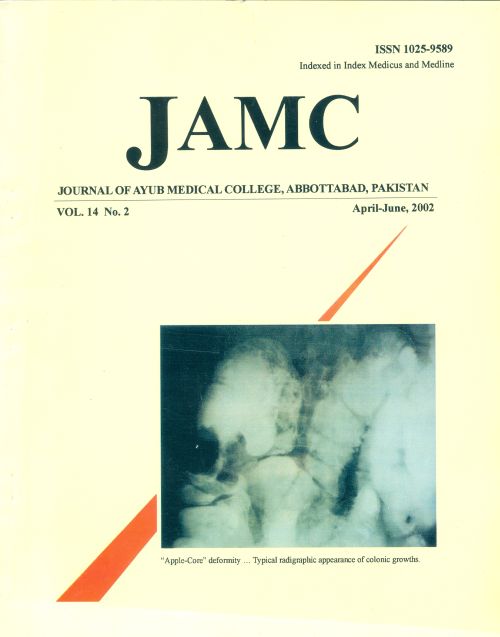CHANGES IN FIBRINOGEN LEVEL IN LIVER CIRRHOSIS
Abstract
Background: Liver cirrhosis causes significant morbidity and mortality in our country, however early diagnosis prevents complications and carries good prognosis. Estimation of fibrinogen level may be helpful in preventing bleeding tendencies. Methods: Plasma fibrinogen level of 82 confirmed liver cirrhosis in 18-60 years age admitted patients of Khyber Teaching Hospital were determined and compared with normal controls, to establish it as a marker for diagnosis in cirrhosis liver and prognosis. Fibrinogen level was determined by Fibriprest-2. Results: Significantly low levels in patients were recorded as compared to controls. 40% cases showed low fibrinogen level, while nearly 44% had normal levels. Conclusion: Fibrinogen level was low in early and terminal cirrhosis and high in advancing cirrhosis as compared to controls that showed normal levels.
KEY WORDS: Cirrhosis, Liver, Fibrinogen.
References
Kwan SW, Fuller GH. Immunochemical characterization of fibrinogen induction in liver. Biochem Biophys Acta (Amst). (1977); pp 475-659.
Roberts HR, Cederbaum AI. The liver and blood coagulation. Physiology and Pathology. Gastroenterology 1972; 63: 297.
Sherlock S. Ascites. Diseases of the liver and biliary system. 5th Ed. pp 122-149. Zullusky R; Furie B. Haematologic complications of liver disease and alcoholism. In Hoffman et al, eds (1), pp 2096-2103.
Bloom AL. Intravascular coagulation and liver. Brit J Haematol 1975; 30: 1.
Lane DA, Scully MF, Thomas DP, Kakkar VV, Woolf IL. Williams R. Acquired dysfibrinogenemia in acute and chronic liver disease. British.J Haematol 1977; 35: 301.
Palascak J, Martinz J. Dysfibrinogenemia associated with liver disease. J Clin Invest 1977; 60: 89.
Barr RD, Ouna N, Simpson JC, Bagshave AF. Dysfibrinogenemia and primary hepatocellular carcinoma. Quart J Med 1986; 45: 647.
Gralnick H, Gilvelber H, Abrams E. Dysfibrinogenemia associated with hepatoma, increased carbohydrate content of fibrinogen molecule. New Engl J Med 1978; 299: 221.
Martinz J, Palascak J, Kawasniak D. Abnormal sialic acid content of the dys- fibrinogenemia associated with liver disease. J Clin Inves 1978; 61: 535.
Calabrese S, Gianstante C, Sammaritini C, Benedetti A. Platelet aggregation and various coagulation parameters in liver cirrhosis. Minerva Medica 1984; 75 (18): 47-52.
Nervaiza MJ, Fernandez J, Cuesta B, Parano JA, Rocha E. Role of sialic acid in acquired dysfibrinogenemia associated with liver cirrhosis. Ricerca in clinica e in laboratorio 1986; 16 (4): 563-8.
Williams EC. Dissiminated inteavascular coagulation. In Loscalgo J. Schafer A I, eds. Thrombosis and haemorrhage. Inded osten; Black well Sceintific. 1994: pp 921-32.
Morsee EE. Fibrinogen and dysfibrinogenemia . Ann Clin Lab Sci 1980; 10 (4): 351-5.
Sallah S, Bobzein W. Bleeding problems in patients with liver disease. Post Graduate Medical Magazine 1999; 106: 4:1
Kelly DA, Tuddenham EG. Haemostatic problems in liver disease. Gut 1986; 27 (2): 339-49.
Ratnoff OD, Forman WB. Criteria for the differentiation of dysfibrinogenemia states. Semin Hematol 1976; 13: 141-157.
Downloads
How to Cite
Issue
Section
License
Journal of Ayub Medical College, Abbottabad is an OPEN ACCESS JOURNAL which means that all content is FREELY available without charge to all users whether registered with the journal or not. The work published by J Ayub Med Coll Abbottabad is licensed and distributed under the creative commons License CC BY ND Attribution-NoDerivs. Material printed in this journal is OPEN to access, and are FREE for use in academic and research work with proper citation. J Ayub Med Coll Abbottabad accepts only original material for publication with the understanding that except for abstracts, no part of the data has been published or will be submitted for publication elsewhere before appearing in J Ayub Med Coll Abbottabad. The Editorial Board of J Ayub Med Coll Abbottabad makes every effort to ensure the accuracy and authenticity of material printed in J Ayub Med Coll Abbottabad. However, conclusions and statements expressed are views of the authors and do not reflect the opinion/policy of J Ayub Med Coll Abbottabad or the Editorial Board.
USERS are allowed to read, download, copy, distribute, print, search, or link to the full texts of the articles, or use them for any other lawful purpose, without asking prior permission from the publisher or the author. This is in accordance with the BOAI definition of open access.
AUTHORS retain the rights of free downloading/unlimited e-print of full text and sharing/disseminating the article without any restriction, by any means including twitter, scholarly collaboration networks such as ResearchGate, Academia.eu, and social media sites such as Twitter, LinkedIn, Google Scholar and any other professional or academic networking site.









